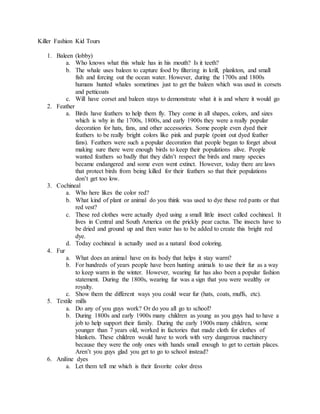
Killer Fashion Kid Tours
- 1. Killer Fashion Kid Tours 1. Baleen (lobby) a. Who knows what this whale has in his mouth? Is it teeth? b. The whale uses baleen to capture food by filtering in krill, plankton, and small fish and forcing out the ocean water. However, during the 1700s and 1800s humans hunted whales sometimes just to get the baleen which was used in corsets and petticoats c. Will have corset and baleen stays to demonstrate what it is and where it would go 2. Feather a. Birds have feathers to help them fly. They come in all shapes, colors, and sizes which is why in the 1700s, 1800s, and early 1900s they were a really popular decoration for hats, fans, and other accessories. Some people even dyed their feathers to be really bright colors like pink and purple (point out dyed feather fans). Feathers were such a popular decoration that people began to forget about making sure there were enough birds to keep their populations alive. People wanted feathers so badly that they didn’t respect the birds and many species became endangered and some even went extinct. However, today there are laws that protect birds from being killed for their feathers so that their populations don’t get too low. 3. Cochineal a. Who here likes the color red? b. What kind of plant or animal do you think was used to dye these red pants or that red vest? c. These red clothes were actually dyed using a small little insect called cochineal. It lives in Central and South America on the prickly pear cactus. The insects have to be dried and ground up and then water has to be added to create this bright red dye. d. Today cochineal is actually used as a natural food coloring. 4. Fur a. What does an animal have on its body that helps it stay warm? b. For hundreds of years people have been hunting animals to use their fur as a way to keep warm in the winter. However, wearing fur has also been a popular fashion statement. During the 1800s, wearing fur was a sign that you were wealthy or royalty. c. Show them the different ways you could wear fur (hats, coats, muffs, etc). 5. Textile mills a. Do any of you guys work? Or do you all go to school? b. During 1800s and early 1900s many children as young as you guys had to have a job to help support their family. During the early 1900s many children, some younger than 7 years old, worked in factories that made cloth for clothes of blankets. These children would have to work with very dangerous machinery because they were the only ones with hands small enough to get to certain places. Aren’t you guys glad you get to go to school instead? 6. Aniline dyes a. Let them tell me which is their favorite color dress
- 2. b. These dyes can be very harmful to the environment. In the old days they were often dumped in the rivers. Today, the US has laws against this kind of dumping, but this kind of pollution is still going on in countries all over the world. I don’t think the fish are too happy about that. 7. Time for questions…. Crafts: Victorian or Empire fashion coloring page Making feather fans